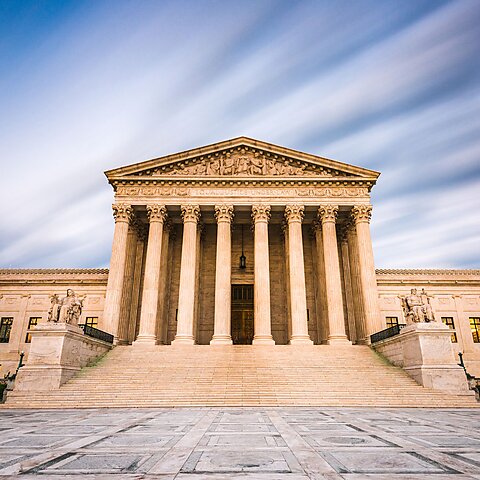It’s the most wonderful time of the year! Last week, on the first Monday in October, the Supreme Court reconvened for a brand new term. It’s slated to be another big one—with cases involving guns, regulation of social media platforms, and several doctrines that have enabled our behemoth administrative state. Here’s a quick recap of the Court’s first week back and the first three oral arguments of the year.
The Court first heard oral arguments in Pulsifer v. United States, which involved a question only the government could love: whether “and” means “or.” In 2018, Congress passed the First Step Act to reduce judges’ reliance on mandatory minimum sentences, which are known to result in arbitrary and unfair punishment. The Act allows judges to depart from minimums when the defendant does not have (A) more than four criminal history points, (B) a certain kind of prior offense, “and” (C) a second kind of offense.
Pulsifer pleaded guilty to distributing at least 50 grams of meth and is therefore subject to a mandatory minimum of fifteen years in prison unless he qualifies for a departure from the minimum. He had more than four criminal history points, had a prior offense under (B), but had not been convicted of an offense under (C). His attorneys argued that he qualified for departure because he did not have (A), (B), and (C). The government, however, argued that “and” means “or,” and a defendant does not qualify for departure from the minimums if he or she has (A), or (B), or (C).
It’s true, of course, that words must be read in context and there really are times when “and” is meant to indicate “or.” As Justice Kagan noted during the argument, if your doctor tells you that, to get a blood test, you should not “eat food, drink any liquids, and smoke,” you would know that your doctor means you should not eat food, drink liquids, or smoke. In that case, what your doctor is trying to communicate by selecting the word “and” is that you should not eat food, you should not drink any liquids, and you should not smoke.
Here, Justice Kagan observed, there’s some reason to think Congress meant “or” when it said “and.” For example, it would be bizarre for Congress to think it’s more disqualifying to have A, B, & C than to have several B offenses, which are more serious. It would also mean that defendants would prefer to be convicted of a higher point crime under (B) than be convicted of a lower point crime under (C), if doing so allowed them to qualify for departure from the minimums. But as Pulsifer’s attorney argued, the justices aren’t permitted to overturn laws merely because they think them odd.
The government argued that judges must assume Congress is an “intelligent drafter” of laws, and an intelligent Congress would have meant “or.” But, of course, Congress very often writes arbitrary, if not irrational, statutes all the time. And as Justice Gorsuch noted, Pulsifer’s interpretation may be odd, but it’s not absurd. Justice Gorsuch also noted that the government didn’t adopt this reading of the statute until late in litigation, casting doubt on its authenticity.
Justice Kagan and Justice Jackson both appeared to have little sympathy for the government’s invitation to deviate from the ordinary meaning of the text. Justice Kagan said that where there’s two permissible interpretations and “where liberty is on the line,” she’d interpret the statute in a way that favors the accused. Similarly, Justice Jackson noted that this was a criminal statute “with huge implications,” and so where there are two textually grammatically possible readings, that should weigh against the government.
While Justices Kagan and Jackson found the case’s criminal context important, there’s good reason to extend the same principles to other enforcement actions. Administrative proceedings, for example, can have tremendous consequences for people’s livelihoods. The Court is slated to hear at least one case involving deference to administrative agencies’ interpretations of law this term. Hopefully, judicial independence and a presumption of liberty will reappear in that context as well.
The second case to be heard, Consumer Financial Protection Bureau (CFPB) v. Consumer Financial Services Association, is one of several cases the Court has taken up this term that has the potential to roll back the sprawling administrative state. But if oral argument is any guide, this challenge won’t be successful.
In 2010, Congress created the CFPB through the Dodd‐Frank Act and authorized it to enforce a new prohibition on “any unfair, deceptive, or abusive act or practice.” To make CFPB “independent,” Congress allowed it to choose its own annual funding in perpetuity subject to a $750 million cap, with unspent funds rolled over each year.
Unlike most other agencies, which are subject to an annual appropriations process, the CFPB director simply requests whatever amount he or she believes is “reasonably necessary.” And even then, the director doesn’t ask Congress, but instead requests money from the Federal Reserve (which is itself outside the normal appropriations process).
Congress also made CFPB’s director unremovable by the president except for cause. But the Supreme Court invalidated that limitation a few terms ago on the basis that it violated the president’s power to remove officers. In other words, the Court recognized that the Bureau had gotten a little too independent.
The plaintiffs in this case similarly argue that it’s funding mechanism has made it too independent. They sued to challenge CFPB’s payday lending rule, which bans lenders from making preauthorized attempts to collect loan payments after two consecutive denials based on insufficient funds. They say allowing CFPB to choose its funding subject to only an illusory cap, in perpetuity, violates the Appropriations Clause. That provision requires all appropriations to come from Congress and plays an important role in keeping unelected bureaucrats accountable to elected officials.
Arguing for the CFPB, Solicitor General Elizabeth Prelogar made the case that CFPB’s structure is grounded in constitutional text and practice. When the Founders wanted to limit Congress’s appropriations authority, she said, they did so explicitly—as they did in the case of the Army Appropriations Clause (which limits appropriations to a two‐year duration). And since the founding, Congress has funded agencies through standing appropriations that give agencies significant discretion over how much money they use. The CFPB’s funding structure, she said, is not materially different.
This broad interpretation of the Appropriations Clause caused Justice Thomas to ask whether there are any limits on how Congress can appropriate funds. The Solicitor General answered that Congress must provide funding for specific purposes from specific sources and it cannot give away its authority entirely, by say, giving a quadrillion dollars to the president to use as he likes.
Prelogar’s heavy reliance on historical practice might have been a consequence of the Court’s recent ruling in New York Pistol Association v. Bruen. In that case, the Court ruled that restrictions on the Second Amendment will only be upheld if an analogous law existed at the time the Amendment was passed. But as Justice Kagan noted, there’s no exact historical analogue to the way Congress has funded CFPB. She therefore asked whether it’s more important that the Court find a historical analogue or that it extrapolates principles from the examples it can find. That’s a question the Court will continue to grapple with as it builds on Bruen.
I’ve argued before that the Court has become too reliant on historical practice. After all, the Constitution enshrines principles, not practices. Practices can inform the meaning of certain words or phrases in the Constitution, but they should not be considered determinative of whether a modern practice is constitutional.
Arguing for the challengers, former Solicitor General Noel Francisco made the case that in funding CFPB, Congress has effectively given away its appropriations power entirely, since the cap is so high that CFPB essentially gets to pick its own budget. Justice Kagan responded that perhaps the fact that CFPB hasn’t met its spending cap suggests that it should be doing more.
The most interesting part of the argument was an exchange between Francisco and Justice Jackson, who asked him where in the Constitution’s text he derived his suggested limits on the appropriations power. Justice Jackson has been said to employ “Progressive Originalism” when interpreting the Constitution, and it will be interesting to see how she develops this methodology as a challenge to the Originalism employed by some of the other justices.
All of the justices seemed to agree there must be some limits to Congress’s ability to delegate away its appropriations power, but most appeared to believe CFPB hadn’t crossed them. So while the case is yet another example of the continuous erosion of the separation of powers and Congress’s propensity to give its power away to unelected, unaccountable agency bureaucrats, it seems unlikely the Court will deem CFPB’s funding mechanism unconstitutional.
The last case the Court heard in its first week back involves the perennial question of “standing,” or what kind of injury a plaintiff must sustain before bringing a lawsuit. Standing disputes take up a surprising amount of lawyers’ time, especially when it comes to constitutional lawsuits, in which government attorneys try to avoid defending laws on the merits and instead get cases dismissed based on procedural technicalities.
In Acheson Hotels v. Laufer, the plaintiff was a woman who surfed hotel websites to see whether they provided disability access information, even though she had no intention of visiting the hotels. “Disability testing” has become something of a cottage industry, with plaintiffs suing hotels for violations of the Americans with Disabilities Act and then settling the lawsuit despite having no interest in visiting the location, and thus no possibility of experiencing disability discrimination. The lower courts ruled that Laufer had standing to sue the hotel, but after the Supreme Court agreed to take up the case, Laufer dismissed her claims against the hotel and argued the Court should deem the case moot. In fact, by the time of oral argument, the case was (in the words of Justice Kagan) “dead, dead, dead.” The hotel had changed hands, its website was fully compliant, and the plaintiff had dismissed her case.
That meant that much of the oral argument centered around whether the Court should still decide the standing question. While several justices suggested the lawsuit was moot, Chief Justice Roberts observed that courts generally must determine whether the plaintiff has standing to bring a claim before determining whether that claim has become moot, and thus there’s nothing odd about taking up the question now.
Justices Thomas and Jackson questioned whether it might be “easier” to just dismiss the case as moot, vacate the court decision below, and wait for a live case to come back to the court at a later time, but Justice Barrett noted that such a path would require more resources in the long run, since it would require entirely new (and duplicative) briefing at a later date. The Chief Justice also noted that a case might never come back to the Court, since a plaintiff could follow the same course of action as Laufer and dismiss his or her claim any time a defendant successfully appealed to the Supreme Court.
After discussing mootness, the Court moved on to whether Laufer had sustained an injury sufficient to bring a lawsuit, asking both attorneys several hypothetical questions related to whether a plaintiff would have standing to sue if they were mere bystanders of racial discrimination.
Justice Jackson, for example, compared Laufer to someone who sees a sign on the door of a restaurant across the street indicating it discriminates, but who never intends to frequent that restaurant. Laufer’s attorney responded that going to the website was not the equivalent of looking at the sign, but instead the equivalent of going to the restaurant and actually being subject to discrimination. In her view, going to the website inflicted a “dignitary harm,” because it deprived Laufer of information “for a reason that conveys that [she has] inferior status in society.” But as Justice Kavanaugh pointed out, all observers of the website are treated the same. The discriminatory treatment doesn’t happen until a person actually gets to the hotel.
It would, at least on the front end, be easier for the Court to kick the can down the road by calling this case moot. The safe bet is that’s exactly what it will do. But at some point the Court will have to clean up standing doctrine, which has become unmoored from the text of the Constitution and is inconsistently applied. At times, courts have applied standing principles too loosely, allowing uninjured plaintiffs to secure huge settlements from innocent businesses. At other times, courts have applied standing too strictly, succumbing to government attorneys’ gamesmanship and kicking civil rights plaintiffs out of courts. Standing doctrine needs a serious clean‐up, but this likely won’t be the case to do it.
The coming weeks will see increasingly consequential cases. If last week was this much fun with cases involving semantics and standing, we anxiously await the rest of the term.




